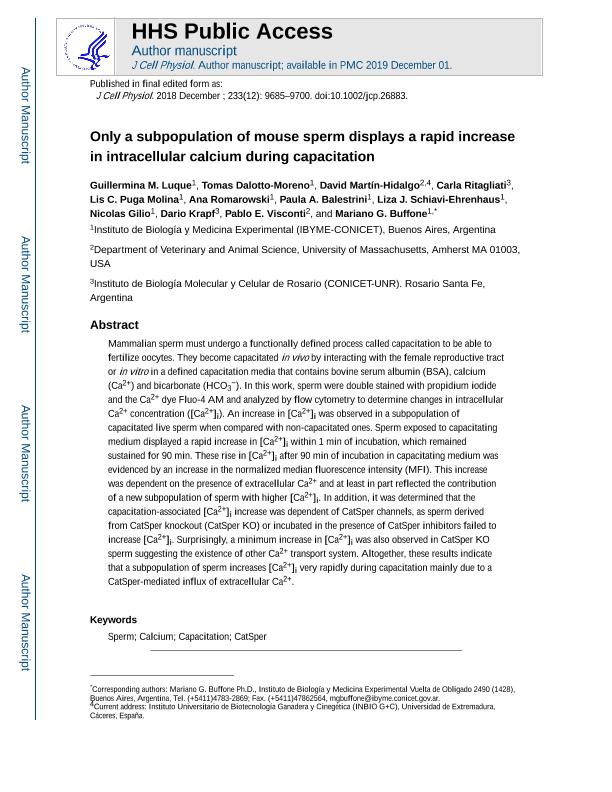Artículo
Only a subpopulation of mouse sperm displays a rapid increase in intracellular calcium during capacitation
Luque, Guillermina Maria ; D'alotto Moreno, Tomas
; D'alotto Moreno, Tomas ; Martín Hidalgo, David; Ritagliati, Carla
; Martín Hidalgo, David; Ritagliati, Carla ; Puga Molina, Lis del Carmen
; Puga Molina, Lis del Carmen ; Romarowski, Ana
; Romarowski, Ana ; Balestrini, Paula Ania
; Balestrini, Paula Ania ; Schiavi Ehrehaus, Liza; Gilio, Nicolas
; Schiavi Ehrehaus, Liza; Gilio, Nicolas ; Krapf, Dario
; Krapf, Dario ; Visconti, Pablo E.; Buffone, Mariano Gabriel
; Visconti, Pablo E.; Buffone, Mariano Gabriel
 ; D'alotto Moreno, Tomas
; D'alotto Moreno, Tomas ; Martín Hidalgo, David; Ritagliati, Carla
; Martín Hidalgo, David; Ritagliati, Carla ; Puga Molina, Lis del Carmen
; Puga Molina, Lis del Carmen ; Romarowski, Ana
; Romarowski, Ana ; Balestrini, Paula Ania
; Balestrini, Paula Ania ; Schiavi Ehrehaus, Liza; Gilio, Nicolas
; Schiavi Ehrehaus, Liza; Gilio, Nicolas ; Krapf, Dario
; Krapf, Dario ; Visconti, Pablo E.; Buffone, Mariano Gabriel
; Visconti, Pablo E.; Buffone, Mariano Gabriel
Fecha de publicación:
12/2018
Editorial:
Wiley-liss, Div John Wiley & Sons Inc
Revista:
Journal of Cellular Physiology
ISSN:
0021-9541
Idioma:
Inglés
Tipo de recurso:
Artículo publicado
Clasificación temática:
Resumen
Mammalian sperm must undergo a functionally defined process called capacitation to be able to fertilize oocytes. They become capacitated in vivo by interacting with the female reproductive tract or in vitro in a defined capacitation medium that contains bovine serum albumin, calcium (Ca2+), and bicarbonate (HCO3 −). In this work, sperm were double stained with propidium iodide and the Ca2+ dye Fluo-4 AM and analyzed by flow cytometry to determine changes in intracellular Ca2+ concentration ([Ca2+]i) in individual live sperm. An increase in [Ca2+]i was observed in a subpopulation of capacitated live sperm when compared with noncapacitated ones. Sperm exposed to the capacitating medium displayed a rapid increase in [Ca2+]i within 1 min of incubation, which remained sustained for 90 min. These rise in [Ca2+]i after 90 min of incubation in the capacitating medium was evidenced by an increase in the normalized median fluorescence intensity. This increase was dependent on the presence of extracellular Ca2+ and, at least in part, reflected the contribution of a new subpopulation of sperm with higher [Ca2+]i. In addition, it was determined that the capacitation-associated [Ca2+]i increase was dependent of CatSper channels, as sperm derived from CatSper knockout (CatSper KO) or incubated in the presence of CatSper inhibitors failed to increase [Ca2+]i. Surprisingly, a minimum increase in [Ca2+]i was also observed in CatSper KO sperm suggesting the existence of other Ca2+ transport systems. Altogether, these results indicate that a subpopulation of sperm increases [Ca2+]i very rapidly during capacitation mainly due to a CatSper-mediated influx of extracellular Ca2+.
Palabras clave:
CALCIUM
,
CAPACITATION
,
CATSPER
,
SPERM
Archivos asociados
Licencia
Identificadores
Colecciones
Articulos(IBR)
Articulos de INST.DE BIOLOGIA MOLECULAR Y CELULAR DE ROSARIO
Articulos de INST.DE BIOLOGIA MOLECULAR Y CELULAR DE ROSARIO
Articulos(IBYME)
Articulos de INST.DE BIOLOGIA Y MEDICINA EXPERIMENTAL (I)
Articulos de INST.DE BIOLOGIA Y MEDICINA EXPERIMENTAL (I)
Citación
Luque, Guillermina Maria; D'alotto Moreno, Tomas; Martín Hidalgo, David; Ritagliati, Carla; Puga Molina, Lis del Carmen; et al.; Only a subpopulation of mouse sperm displays a rapid increase in intracellular calcium during capacitation; Wiley-liss, Div John Wiley & Sons Inc; Journal of Cellular Physiology; 233; 12; 12-2018; 9685-9700
Compartir
Altmétricas



